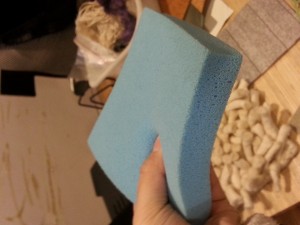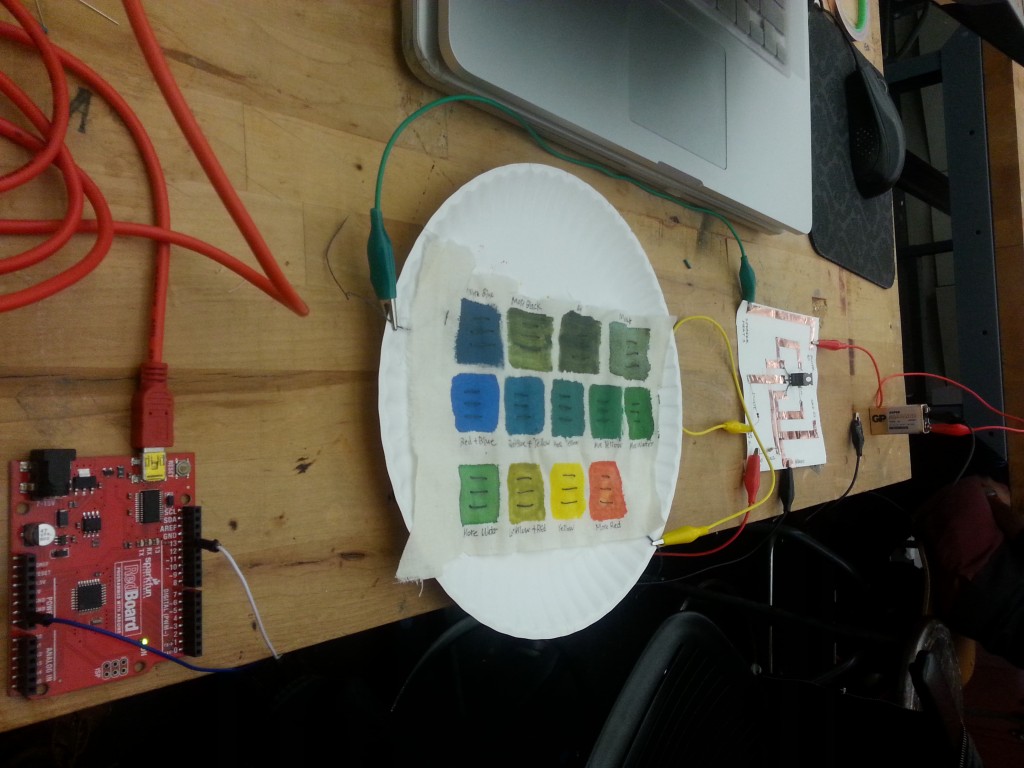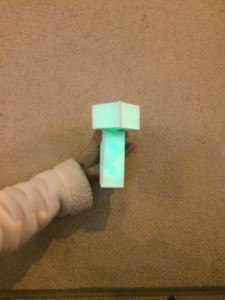(Former assignment I didn’t post before.)
1. Bite
2. Connect – Mobius Strip
3. Pull – Paper Fox
1. Basketweave – Plynyl
One of the oldest and simplest of weaving constructions. But it has been substituted with petroleum-based plasticizers in this innovative new yarn to make it soft.
2. Bear Grass – 3Form
Very interesting material. This could be used for floor or to decorate wall to create a natural atmosphere. This material used natural products as a decorative interlayer which may change its appearance over time. Even more interesting.
3. Aearo – E.A.R
This material is used for ear plug, which is very soft. Its highly damping and isolation features effectively control impact noise and vibration.

I teamed with Xiaofeng Lin in this thermochromic ink experiment.
We decided to test out with different ingredients in these little squares. Ingredients are marked aside.
We then heated it up and found out only Blue left, and whichever square without Blue in it disappeared.
We sewed conductive thread in each of the square and wanted to know if the circuit can bear this length of resistance.

It turned out only two rows of conductive thread worked, and three rows failed. The squares in the second row that didn’t work quite well may be too thick when we painted.
We measured the resistance of three rows and calculated how many resistance this circuit can bear to heat up.
I teamed with Xiaoqi Liu, and Alec. Below is the link to our experiment.
http://lizastark.com/compcraftfall14/flexinol-in-class-testxiaoqi-grace-alec/
I teamed with Xinhe Feng, Xiaofeng Lin, and Yang Wang. Below is the link to our experiment.
http://lizastark.com/compcraftfall14/paper-speaker-xinhe-xiaofeng-grace-yang/
[Documentation]
Self Contain Battery
Self Contain Switch
[Problem]
I’ve been having this problem for long: if the bathroom sign is hang on the door and the door is open, I don’t know which direction it points. Sometimes I can’t even see the sign from certain angles.
Also, I’m having a hard time recognizing some 2D signs which share the same meaning but look differently. There are also directions that 2D signs are hard to represent.  [Concept]
[Concept]
To solve my problems above, I decided to make a sign lamp that can easily change its pointing directions in a 3D space using basic soft circuitry.
[Prototype]
The lamp includes two part: the base lamp and arrow lamp.
Benefit 1: Simple click to change directions
Benefit 2: Change dimension easily when needed
Benefit 3: Point to directions that are not easily represented in 2D signs  [Challenge]
[Challenge]
1. How to make both parts light up when snapped.
2. How to design layers of circuit so that it works in four sides of the arrow lamp.
[Documentation]
Want to know more about how I designed the soft circuit? Check out my Instructables!
Below is a video documentation of this project:
Group Member: Grace Tingshan Gou, Elena Yang Wang, Tim Xiaofeng Lin
Description:
Our group wants to start something really basic and normal, no fun no technologies at all. The result is a pillow. We bought one yard material from Mood and a 14″ x 14″ pillow as a start.
1. We cut the materials into three pieces: 15″ x 15″, 15″ x 10″, 15″ x 8″, and folded the edges half inch inside and sewed them two times.
2. At first the pace of my foot and the speed moving the material didn’t fit each other, so the threads were messed up and stuck into each stitch along sewing.
3. But then when we find the right pace everything came along. Apart from the pace, lining them straight was also very difficult. As can be seen below, it was not a perfect square.
4. Done! When we folded them inside out, everything looked perfect again. We wanted to manually sew some decorations onto this little pillow and give it to someone as a gift:)
1. In-Class Parallel Circuity – Light up Apple’s Icon
Enjoy the “Right!” moment:
2. Illustration Practice – Chocolate Package Design
A chocolate package design that only when people unwrap the package that they are able to see the rest of the famous quote, which is “you never know what you gonna get”, just like the way this line shows.
Some Steps:
1. Prepare materials and tools, and write down the quote in its horizontal flip.
2. Make holes for 7 LEDs, and build a parallel circuit using copper tape and a coin battery.
3. Check functionality and make switches.
4. Use switches to separate LEDs from copper tape, and enclose the whole chocolate box.
5. Enjoy the moment opening it! (Quote may not be clear in phone camera)
Four college students from North Carolina State University have started to invent a nail polish that changes color when it contacts with date-rape drugs, including Rohypnol, Xanax, and GHB. They markets themselves to be “the first fashion company empowering women to prevent sexual assault”.
This product may not relate to any materials we talked about in class, but I found this one a very brilliant use of wearable technology, and also a very good combination of technology and social issue. When it comes to wearable/crafting technology products or accessaries, we often think of how to enclose the technical things using beautiful covering materials or sewing skills and make it neat, but this one just remains the original decoration. Although this doesn’t use any circuits and it more relates to the chemical reaction, it provides me an additional option of how to make my project neat.
The image below indicates how this product works in pubs and bars. As you can see, when woman want to detect their drinks, they have to put their fingers into the cup and stir. Some people think it is not the neat part when it comes to use. Also an article came right after their promotion, saying they don’t really understand anything about sexual assaults and most of the sexual assaults do not happen in the bars and relate to drinks.
These reviews may have their point of view, but this product opens the possibilities of using our body decorations as a practical way to protect ourselves. In the aspect of computational craft, this also inspires me to use certain parts of my body to be the conductive switch that triggers a circuit.